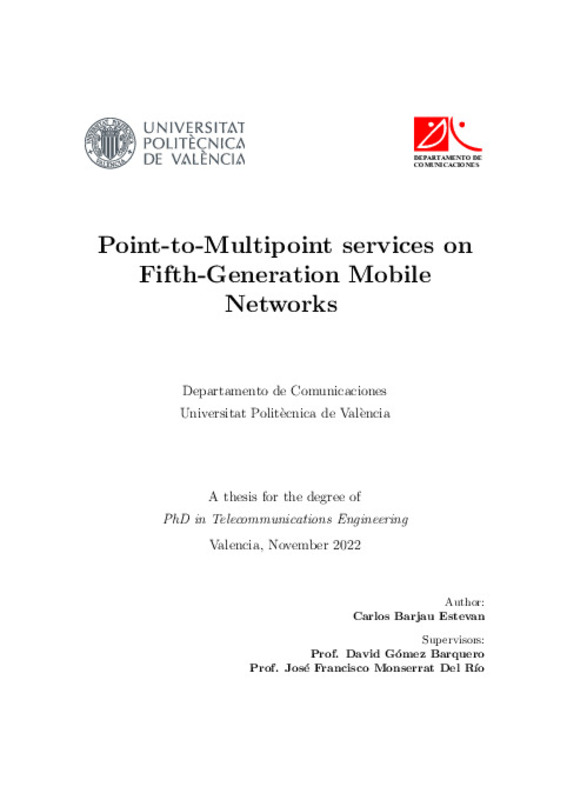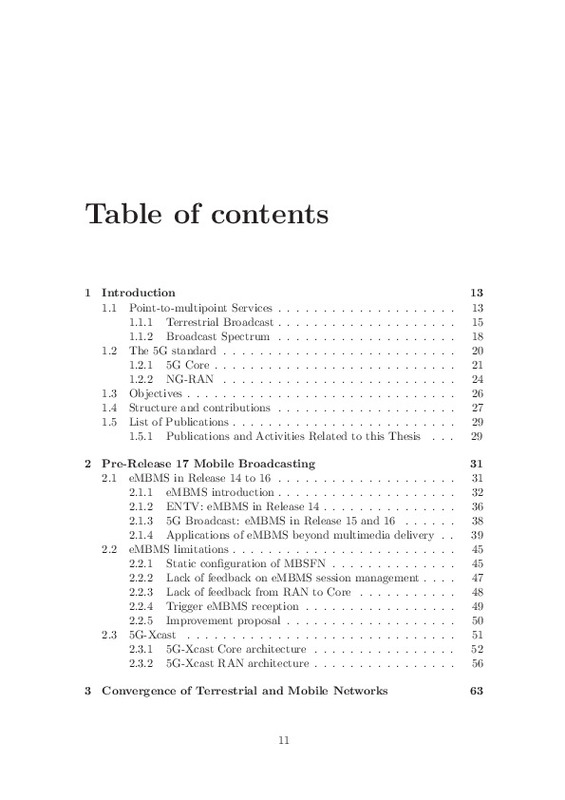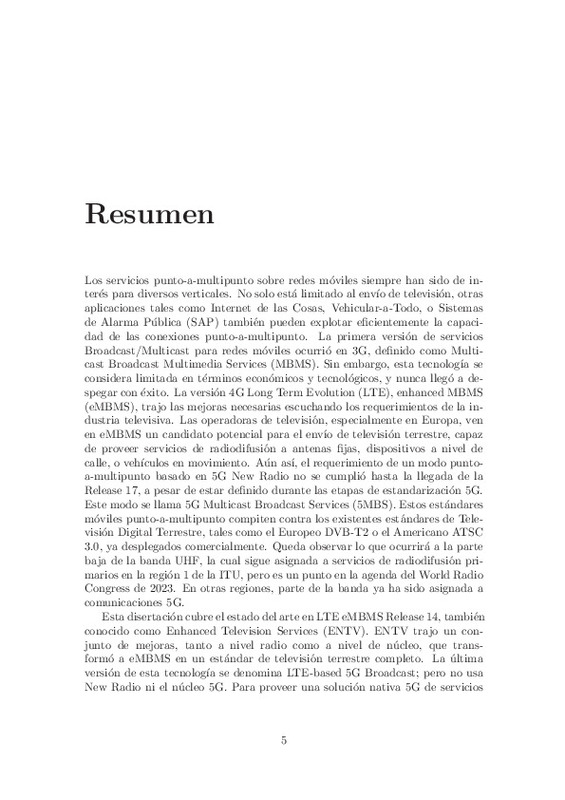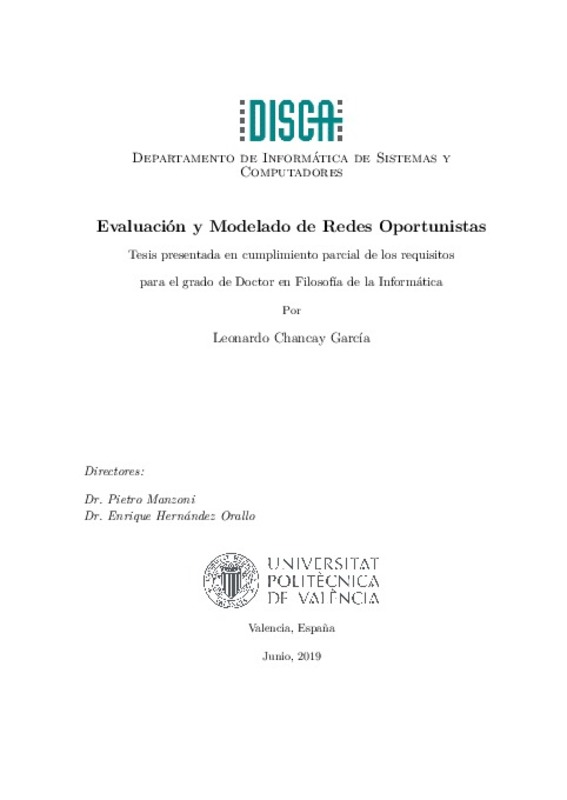- RiuNet repositorio UPV
- :
- Investigación
- :
- Tesis doctorales
- :
- Ver ítem
JavaScript is disabled for your browser. Some features of this site may not work without it.
Buscar en RiuNet
Listar
Mi cuenta
Estadísticas
Ayuda RiuNet
Admin. UPV
Point-to-Multipoint Services on Fifth-Generation Mobile Networks
Mostrar el registro sencillo del ítem
Ficheros en el ítem
| dc.contributor.advisor | Gómez Barquero, David
|
es_ES |
| dc.contributor.author | Barjau Estevan, Carlos Salvador
|
es_ES |
| dc.date.accessioned | 2023-01-20T10:24:36Z | |
| dc.date.available | 2023-01-20T10:24:36Z | |
| dc.date.created | 2022-12-19 | |
| dc.date.issued | 2023-01-20 | es_ES |
| dc.identifier.uri | http://hdl.handle.net/10251/191408 | |
| dc.description.abstract | [ES] Esta disertación cubre el estado del arte en LTE eMBMS Release 14, también conocido como Enhanced Television Services (ENTV). ENTV trajo un conjunto de mejoras, tanto a nivel radio como a nivel de núcleo, que transformó a eMBMS en un estándar de televisión terrestre completo. La última versión de esta tecnología se denomina LTE-based 5G Broadcast; pero no usa New Radio ni el núcleo 5G. Para proveer una solución nativa 5G de servicios punto-a-multipunto, hubo investigación en entornos acad\'emicos y colaboraciones público-privada. La iniciativa más notable en este aspecto fue el proyecto del Horizon 2020 5G-Xcast, que transcurrió de 2017 a 2019. 5G-Xcast produjo varias soluciones a nivel de arquitectura, desde la perspectiva de provisión de contenidos, nuevas funciones de red interoperables con el núcleo 5G, hasta modificaciones a la interfaz aire basada en New Radio. Los hallazgos del proyecto están descritos en esta tesis. La tesis incluye dos ejemplos de eMBMS aplicados a verticales diferentes, una para el uso de eMBMS en entornos industriales, y otra presentando eMBMS como un sistema SAP. Incluir servicios punto-a-multipunto como un modo adicional celular trae algunos desafíos, como ya mostró la estandarización de eMBMS: las redes de radiodifusión terrestre y las redes celulares son muy distintas entre ellas. Encontrar una forma de onda viable para ambas infraestructuras es complejo. Esta tesis ofrece un punto de vista distinto al problema: un escenario de colaboración entre cadenas televisivas y operadores móviles, donde la infraestructura de radiodifusión y móvil son compartidas. Este concepto se ha definido como Convergence of Terrestrial and Mobile Networks. Las tecnologías elegidas para converger son ATSC 3.0 y 5G, usando el Advanced Traffic Steering, Switching and Splitting (ATSSS). ATSSS está compuesto de una serie de procedimientos, interfaces, funciones de red, para permitir el uso compartido de un acceso 3GPP con uno non-3GPP, como Wi-Fi. Sin embargo, el uso de ATSSS para juntar radiodifusión y celular no es trivial, ya que ATSSS no fue dise\~{n}ado para enlaces radio unidireccionales como ATSC 3.0. Estas limitaciones son descritas en detalle, y una propuesta para solventarlas tambi\'en está incluida. La solución se basa en Quick UDP Internet Connections (QUIC), y se usa como ejemplo para la provisión de Convergent Services (File Repair y Video Offloading). La tesis concluye con una descripción de Release 17 5MBS, con los nuevos conceptos introducidos. 5MBS es capaz de cambiar entre unicast, multicast y broadcast; dependiendo del servicio, la ubicación geográfica de los usuarios, y las capacidades de la infraestructura móvil involucradas. Para evaluar 5MBS, se ha realizado un estudio de prestaciones, basado en comunicaciones multicast dentro del núcleo de red 5G. Este prototipo 5MBS forma parte del laboratorio VLC Campus 5G, y utiliza el software comercial Open5GCore como base del desarrollo. El modelo de sistema para la experimentación esta formado por un servidor de vídeo, que se conecta al Open5GCore y a las funciones de red mejoradas con funcionalidades 5MBS. Estas funciones de red envían el contenido mediante punto-a-multipunto a un entorno radio y terminales simulados. Los resultados obtenidos resaltan el objetivo principal de la tesis: las comunicaciones punto-a-multipunto son una solución escalable para el envío de contenido multimedia en directo. | es_ES |
| dc.description.abstract | [CA] Aquesta dissertació cobreix capdavanter en LTE eMBMS Release 14, també conegut com Enhanced Television Services (ENTV). ENTV va portar un conjunt de millores, tant a nivell de ràdio com a nivell de nucli, que va transformar el eMBMS en un estàndard de televisió terrestre complet. La última versió d'aquesta tecnologia es denomina LTE-based 5G Broadcast; però no fa servir New Ràdio ni el nucli 5G. Per a proveir una solució nativa 5G de serveis punt-a-multipunt, va haver-hi investigació en entorns acadèmics i col·laboracions pública i privada. La iniciativa més notable en aquest aspecte va ser el projecte del Horizon 2020 5G-Xcast, que va transcórrer del 2017 a 2019. 5G-Xcast va produir diverses solucions a nivell d'arquitectura, des de la perspectiva de provisió de continguts, noves funcions de xarxa interoperables amb el nucli 5G, fins a modificacions a la interfície aire basada en New Radio. Les troballes del projecte estan descrits en aquesta tesi. La tesi inclou dos exemples de eMBMS aplicats a verticals diferents, una per a l'ús de eMBMS en entorns industrials, i una altra presentant eMBMS com un sistema SAP. Incloure serveis punt-a-multipunt com una manera addicional cel·lular duu alguns desafiaments, com ja va mostrar l'estandardització de eMBMS: les xarxes de radiodifusió terrestre i les xarxes cel·lulars són molt diferents entre elles. Trobar una forma d'ona viable per a totes dues infraestructures és complex. Aquesta tesi ofereix un punt de vista diferent al problema: un escenari de col·laboració entre cadenes televisives i operadors mòbils, on la infraestructura de radiodifusió i mòbil són compartides. Aquest concepte s'ha definit com Convergence of Terrestrial and Mobile Networks. Les tecnologies triades per a convergir són ATSC 3.0 i 5G, usant el Advanced Traffic Steering, Switching and Splitting (ATSSS). ATSSS està compost d'una sèrie de procediments, interfícies, funcions de xarxa, per a permetre l'ús compartit d'un accés 3GPP amb un non-3GPP, com a Wi-Fi. No obstant això, l'ús de ATSSS per a adjuntar radiodifusió i cel·lular no és trivial, ja que ATSSS no va ser dissenyada per a per a enllaços ràdio unidireccionals com ATSC 3.0. Aquestes limitacions són descrites detalladament, i una proposta per a solucionar-les també està inclosa. La solució es basa en Quick UDP Internet Connections (QUIC), i s'usa com a exemple per a la provisió de Convergent Services (File Repair i Vídeo Offloading). La tesi conclou amb una descripció de Release 17 5MBS, amb els nous conceptes introduïts. 5MBS és capaç de canviar entre unicast, multicast i broadcast; depenent del servei, la ubicació geogràfica dels usuaris, i les capacitats de la infraestructura mòbil involucrades. Per a avaluar 5MBS, s'ha realitzat un estudi de prestacions, basat en comunicacions multicast dins del nucli de xarxa 5G. Aquest prototip 5MBS forma part del laboratori VLC Campus 5G, i utilitza el programari comercial Open5GCore com a base del desenvolupament. El model de sistema per a l'experimentació està format per un servidor de vídeo, que es connecta al Open5GCore i a les funcions de xarxa millorades amb funcionalitats 5MBS. Aquestes funcions de xarxa envien el contingut mitjançant punt-a-multipunt a un entorn ràdio i terminals simulats. Els resultats obtinguts ressalten l'objectiu principal de la tesi: les comunicacions punt-a-multipunt són una solució escalable per a l'enviament de contingut multimèdia en directe. | es_ES |
| dc.description.abstract | [EN] This dissertation covers the state-of-the-art in LTE eMBMS Release 14, also known as Enhanced Television Services (ENTV). ENTV provided a suite of radio and core enhancements that made eMBMS into a viable terrestrial broadcast standard. The latest iteration of this technology is known as LTE-based 5G Broadcast; even though it is not New Radio or 5G Core based. To bridge this gap, research efforts by academia, public and private enterprises evaluated how to provide a 5G-based solution for point-to-multipoint services. The most notable effort in this regard is the Horizon 2020 project 5G-Xcast, which ran from 2017 to 2019. 5G-Xcast provided several architectural solutions, from the content delivery perspective down to air interface specifics; providing new waveforms based on New Radio and Network Functions interoperable with a Release 15 5G Core. The findings are summarized in this thesis. Two examples of eMBMS applied to different verticals are included in the thesis, one for the use of eMBMS in industrial environments, and the other using eMBMS as a PWS technology. Providing point-to-multipoint services as another cellular service poses some problems, as the standardization process of eMBMS showed: the broadcast infrastructure is different than the cellular one. Having a waveform that is suited for both scenarios is a difficult endeavour. The thesis provides a new perspective into this problem: Having existing Terrestrial Broadcast standards and infrastructure be the point-to-multipoint solution of 5G, where mobile operators and broadcasters collaborate together. This is defined in the dissertation as Convergence of Terrestrial and Mobile Networks. The technologies chosen to be converged together were ATSC 3.0 and 5G; using the existing Release 16 framework known as Advanced Traffic Steering, Switching and Splitting (ATSSS). ATSSS is a series of procedures, interfaces, new Network Functions, to allow the joint use of a 3GPP Access Network alongside a non-3GPP one, like Wi-Fi. However, the use of ATSSS for cellular plus broadcast brings challenges, as the ATSSS technology was not designed to be used with a unidirectional access network like ATSC 3.0. These limitations are described in detail, and an architectural proposal that overcomes the limitations is proposed. This solution is based on Quick UDP Internet Connections (QUIC), and how to provide Convergent Services (i.e File Repair and Video Offloading) is shown. The thesis concludes with a description of Release 17 5MBS, including the new concepts introduced. 5MBS features the capacity of switching between unicast, multicast and broadcast; depending on the service addressed, the geographical location of the users, and the capability of the RAN infrastructure targeted. In order to evaluate 5MBS, a performance study of the use of multicast inside the 5G Core has been carried out. The 5MBS prototype was developed as part of the VLC Campus 5G laboratory, using the commercial software Open5GCore which provides the libraries and Network Functions to deploy your own 5G Private Network in testing environments. The system model of the experiment is formed by a video server, connected to the Open5GCore and the 5MBS enhanced functions; which will deliver the content to an emulated RAN environment hosting virtual gNBs and devices. The results obtained reinforce the objective of the thesis, positioning point-to-multipoint as a scalable way to deliver live content. | es_ES |
| dc.description.sponsorship | Research projects: 5G-Xcast: Broadcast and Multicast Communication Enablers for the Fifth-Generation of Wireless Systems (H2020 No 761498); 5G-TOURS: SmarT mObility, media and e-health for toURists and citizenS (H2020 No 856950); FUDGE-5G: FUlly DisinteGrated private nEtworks for 5G verticals (H2020 No 957242). | es_ES |
| dc.format.extent | 143 | es_ES |
| dc.language | Inglés | es_ES |
| dc.publisher | Universitat Politècnica de València | es_ES |
| dc.rights | Reserva de todos los derechos | es_ES |
| dc.subject | Radiodifusión móvil | es_ES |
| dc.subject | Redes móviles | es_ES |
| dc.subject | Redes inalámbricas multidifusión | es_ES |
| dc.subject | Servicio de multidifusión de difusión multimedia evolucionado (eMBMS) | es_ES |
| dc.subject | Redes móviles 5G | es_ES |
| dc.subject | 5G | es_ES |
| dc.subject | Broadcast technology | es_ES |
| dc.subject | Multicast wireless networks | es_ES |
| dc.subject | New radio | es_ES |
| dc.subject | Evolved Multimedia Broadcast and Multicast Services (eMBMS) | es_ES |
| dc.subject | ATSC 3.0 | es_ES |
| dc.subject | Convergence | es_ES |
| dc.subject | 5MBS | es_ES |
| dc.subject | Core network | es_ES |
| dc.subject | 5G Core | es_ES |
| dc.subject | 5G mobile networks | es_ES |
| dc.subject | Enhanced Television Services (ENTV) | es_ES |
| dc.subject | Mobile networks | es_ES |
| dc.subject | Mobile broadcasting | es_ES |
| dc.subject.classification | TEORÍA DE LA SEÑAL Y COMUNICACIONES | es_ES |
| dc.title | Point-to-Multipoint Services on Fifth-Generation Mobile Networks | es_ES |
| dc.type | Tesis doctoral | es_ES |
| dc.identifier.doi | 10.4995/Thesis/10251/191408 | es_ES |
| dc.relation.projectID | info:eu-repo/grantAgreement/EC/H2020/957242/EU/FUlly DisinteGrated private nEtworks for 5G verticals/FUDGE-5G | es_ES |
| dc.relation.projectID | info:eu-repo/grantAgreement/EC/H2020/856950/EU/SmarT mObility, media and e-health for toURists and citizenS/5G_TOURS | es_ES |
| dc.relation.projectID | info:eu-repo/grantAgreement/EC/H2020/761498/EU/Broadcast and Multicast Communication Enablers for the Fifth-Generation of Wireless Systems/5G-Xcast | es_ES |
| dc.rights.accessRights | Abierto | es_ES |
| dc.contributor.affiliation | Universitat Politècnica de València. Departamento de Comunicaciones - Departament de Comunicacions | es_ES |
| dc.description.bibliographicCitation | Barjau Estevan, CS. (2022). Point-to-Multipoint Services on Fifth-Generation Mobile Networks [Tesis doctoral]. Universitat Politècnica de València. https://doi.org/10.4995/Thesis/10251/191408 | es_ES |
| dc.description.accrualMethod | TESIS | es_ES |
| dc.type.version | info:eu-repo/semantics/acceptedVersion | es_ES |
| dc.relation.pasarela | TESIS\12677 | es_ES |
| dc.contributor.funder | European Commission | es_ES |
Este ítem aparece en la(s) siguiente(s) colección(ones)
-
Tesis doctorales [5422]













